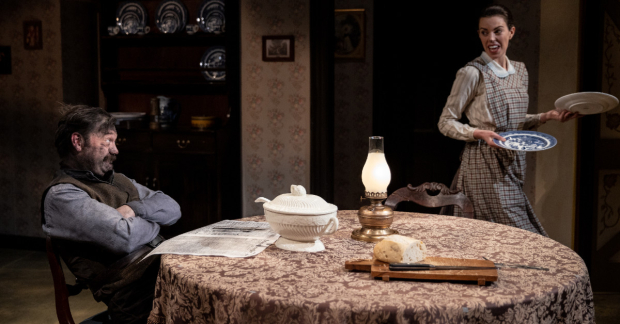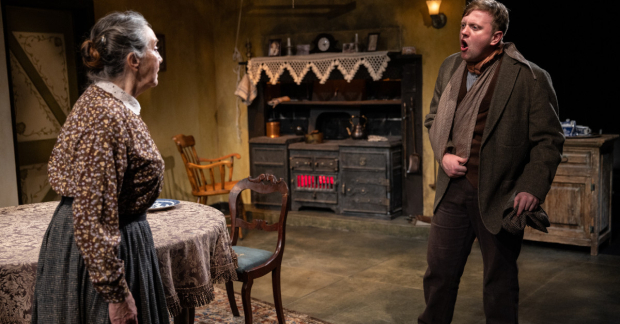Review: Sons and Mothers Have It Out in The Daughter-in-Law
The Mint revisits D.H. Lawrence’s early play at New York City Center.

(© Maria Baranova)
D.H. Lawrence, known for novels that explore sexual longing and fulfillment amid a backdrop of dehumanizing industrialization and oppressive social norms, didn't achieve much recognition as a playwright during his lifetime. In 1913, when his first important work, Sons and Lovers, was published, he was also busy on the play The Daughter-in-Law, many of whose themes overlap with that novel. The play had to wait till 1967 for its first production (37 years after Lawrence's death), and by that time his name was associated with controversial, sexually explicit novels that scandalized polite society and delighted furtive readers. But if audiences were expecting titillation in The Daughter-in-Law, they were most likely disappointed. Lady Chatterley's Lover it is not.
The Mint theater revived the play in 2003 and has done so again now in a brilliantly acted if sometimes exhausting production running at New York City Center. The ensemble cast, under the direction Martin Platt (who also helmed the 2003 production), brings Lawrence's characters to life with their thick East Midlands dialect (dialect designer Amy Stoller provides a short glossary of words in the program). Sandra Shipley plays Mrs. Gascoyne, the stern mother of two coal miners who are psychologically tethered to her in a way that makes them poorly suited to be husbands. Joe (Ciaran Bowling), who fakes an arm injury to get worker's compensation, still lives at home, while his rough-hewn brother, Luther (Tom Coiner), has married up after getting to know the educated Minnie (Amy Blackman).

(© Maria Baranova)
Amid an impending and potentially dangerous mining strike, the family gets word that the daughter of their neighbor Mrs. Purdy (Polly McKie) is with child and that Luther is the father. The news throws Minnie into a spiral about her marriage, but she realizes that Mrs. Gascoyne has made Luther into an unambitious man-child who can't function as a husband. Only after Minnie confronts them with that truth does the family begin to face the psychological bondage that they've kept each other in for so many years.
On the one hand, it's fascinating to see the situations we read in Lawrence's novels being thrashed out onstage. Coiner deserves special mention for his rough-and-ready portrayal of Luther, and Blackman provides an excellent match with her Minnie, their run-ins exemplifying the struggle between classes that Lawrence probably witnessed with his own parents. We also see Lawrence's preoccupation with the psychic tensions that exist between domineering mothers and their sons in scenes that would give shivers of delight to any Freudian critic. Like Sons and Lovers, The Daughter-in-Law revels in a good old-fashioned Oedipus complex.
Bill Clarke's set, depicting Luther and Minnie's modest dining room and kitchen, and Jeff Nellis's dim lighting create a sepia-toned backdrop for the family drama that unfolds over two and a half hours. Holly Poe Durbin's period working-class costumes blend in seamlessly with the characters' surroundings to create an atmosphere of quiet unrest, in response to the greedy mining management outside and the familial threats from within. Plates are smashed and loud words are exchanged as the family fights and Minnie unleashes her resentment toward her good-for-nothing husband and her controlling mother-in-law. That makes for some engaging drama.
But there's no getting around the play's long-winded and woolly plot. Lawrence's talky scenes at times strain patience even without the challenge of tuning the ear to the characters' distinctive dialect, and the sentimental ending comes so unexpectedly that we're left wondering for a moment if it is in fact the end. The Daughter-in-Law marked a promising beginning for Lawrence the playwright; yet it is, on the whole, an apprentice piece that allowed him to explore themes that he would delve into more deeply and successfully in his novels. As an insightful example of a great writer learning his craft, The Daughter-in-Law has value, but a great play it is not.









